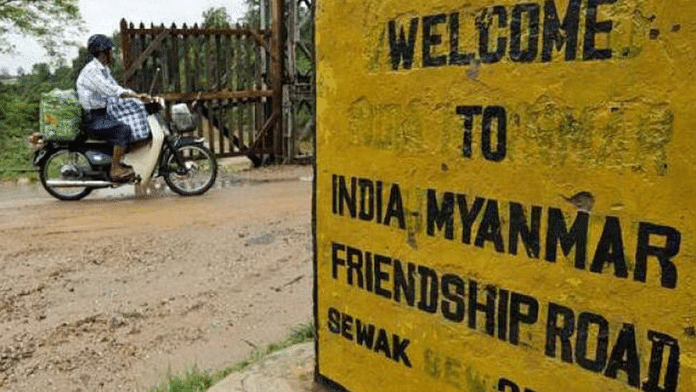New Delhi: Union Home Minister Amit Shah Tuesday announced that the Centre will be fencing the entire 1,643 km long India-Myanmar border, confirming New Delhi’s intent to implement the measures announced earlier last month on ending the Free Movement Regime (FMR) with its eastern neighbour.
Although several internal security analysts have favoured this step, others with a strategic and regional vision question the move saying that it is contrary to India’s ‘Act East Policy’.
Announced by Prime Minister Narendra Modi in 2014, the ‘Act East Policy’ is a successor to the earlier ‘Look East Policy’ conceived in 1991 as an economic initiative. It focuses on India’s extended neighbourhood in the Asia-Pacific and has expanded New Delhi’s previous approach to include political, strategic, and cultural engagements with its partners in the region.
One part of the policy is the Free Movement Regime, or the FMR. Established by a mutual agreement between India and Myanmar in 2018, this arrangement allows tribes living along the border on either side to travel up to 16 km inside the other country without a visa.
The turmoil in Myanmar is seen by some as a dent in India’s Act East Policy.
The Indian government’s decision to fence the borders has drawn diverging views among experts ThePrint reached out to, which further highlights the complicated nature of New Delhi’s relationship with Naypyidaw.
Also Read: India-Myanmar share an imperfect, complex history. Insurgency, drug trade led to permit system
Border fencing a necessity?
The policy of building a border fence in the region is not new and has been the Indian policy for a while, Prabir De, professor at the New Delhi–based Research and Information System for Developing Countries (RIS), explained to ThePrint.
“Building border fences will, in fact, strengthen our (India’s) Act East policy, as a safe and secure border is necessary for free trade to flourish,” De said. “If economies are strong and doing well with no security threats, the borders will be dismantled. As that is not the case with Myanmar currently, a fence is a necessity.”
However, former Indian ambassador to Myanmar, Gautam Mukhopadhaya, said that building a border fence was a “pointless solution to a false problem”.
The main cross-border threat posed by Myanmar to India has been the presence of Valley-based and other Indian Insurgent Groups in Myanmar, he told ThePrint. “But they are not the reason why border fencing is being introduced. They are being introduced on the pretext of a false narrative of ‘illegal migration’ and ‘external aggression’ by the Kuki-Hmar-Zomi tribes.”
The former diplomat was referring to the situation in Manipur, where ethnic violence erupted on 3 May last year between the Valley-based Meiteis, a non-tribal group, and the hills-based Kuki tribes.
Border fences divide people with kinship and tribal ties, incur huge costs in erecting, and rarely work to prevent what they are intended to achieve, Mukhopadhaya said.
“Besides land acquisition and construction, they require huge investments in surveillance, monitoring, and patrolling. The over 400 km Manipur-Myanmar border is all inhabited by tribals, Nagas and Kuki Zo, who are opposed to the fencing. The area is hilly, forested, and prone to landslides, and therefore difficult to construct and maintain.”
The fence, according to him, would become a “source” of further tension with the tribal communities in the region and would act as an “irritant” in cross-border ties among the people.
“It is worth remembering that many of the border tribes of India’s Northeast accepted the India-Myanmar boundary line on the understanding that the FMR would facilitate time honoured, traditional kinship and other ties,” he said. “With the fencing and its impact on the FMR, restive tribal communities on both sides that are deeply attached to their tribal integrity could question the current borders, creating serious problems between India and Myanmar itself in the throes of revolutionary change.”
Sreeparna Banerjee, a junior fellow with the Observer Research Foundation (ORF), has a similar view on the reasons for the introduction of the FMR. The policy, she said, “facilitated unrestricted travel within a 16-kilometre radius without the need for a visa or other documentation.”
India’s Myanmar conundrum
1 February 2024 marked three years since the coup by the Myanmarese junta in 2021. On the same day, Ministry of External Affairs (MEA) spokesperson Randhir Jaiswal highlighted during a regular briefing that the situation in Myanmar has a “direct implication” for India.
New Delhi’s unease with the internal security situation in Myanmar was further highlighted when the MEA Tuesday put out a travel advisory for Indians to leave Rakhine State, where there’s ongoing sectarian violence between the Rohingya Muslim and Rakhine Buddhist communities.
For De, the ongoing insurgency in Myanmar along with the current open borders has helped drug trafficking, human trafficking, and arms smuggling to flourish in the region. He also acknowledges that while the Northeast is India’s bridge to Southeast Asia, “it can function best when there are no security issues in the region.”
Mukhopadhaya, however, points out that the FMR and the open borders had been working satisfactorily in promoting ground-level ties with Myanmar and that there were no serious complaints about its misuse until the current crisis engulfing the neighbouring country.
But according to Banerjee, the reconsideration of the FMR would not necessarily impact India’s ‘Act East Policy’ and is rooted in the “complex challenges of insurgencies, smuggling, and the drug trade”.
She also pointed out that the decision to create the border fences has been made in consultation with the military junta and aligns with India’s long-standing policy of engaging with the administration in power.
“This pragmatic approach allows India to navigate complex geopolitical landscapes while safeguarding its security interests. In essence, the decision to fence the borders, when viewed in the context of India’s historical diplomatic stance, reflects a continuity rather than a departure from established policy norms,” the junior fellow at the ORF said.
(Edited by Uttara Ramaswamy)
Also Read: Extortion cases rise again in Imphal; businessmen, govt employees, farmers queue up for arms licence



